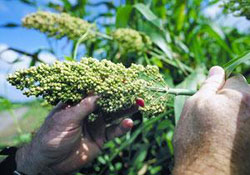Genome analysis of heat-resistant and drought-resistant cereals in the face of climate change risks.
Global climate is changing, and these changes have affected the supply and safety of food. People living in dry areas need plants that can grow well in this condition.
An example is sorghum (also known as milo, millet, corn broom), which is a shrub that can grow up to 5 meters tall and can withstand Dry, hot conditions. This African-origin plant can thrive in areas with harsh conditions where other grains cannot survive because of lack of water. In hot, dry and temperate regions in the Americas, Asia and Europe, they are used as a source of food and feed for animals, and they are also grown to produce bio-fuels. This plant also provides raw fabric and is used as a fuel for heating and cooking.
As part of an international team of scientists, scientists at Helmholtz Zentrum München are analyzing sorghum genes, the first African-origin plant to be genetically sequenced. .
Dr Klaus Mayer (Helmholtz Zentrum München's Institute of Informatics and Biological Systems) said about the purpose of the study: 'We want to elucidate the function and genome structure of sorghum.' He explained: 'This is a prerequisite for improving this important crop to make them more productive in strategic farming conditions. According to the German Center for Environmental Health Research, maintaining food supply is one of our most important research directions. That is why we try to understand the molecular basis of this drought-resistant plant in order to apply that achievement to other crops in our area. ' The first results of this study were published in the journal Nature.

Sorghum (Source: American Agricultural Institute)
The important thing that makes sorghum a model in this study is because it is closer to tropical grains (such as yellow corn grain) than water rice. In addition, unlike other crops, sorghum genome has not been altered and enlarged after millions of years. Its compact genome (about a quarter of the human genome) will give a good start to studying more complex crops such as corn or sugarcane, another special thing is that the sorghum also has an optical system. mix C4 like the above two plants.
Based on morphological and biochemical characteristics, these plants use a special photosynthetic pathway (in the name of the name, the first sugar molecule is made up of 4 carbon). They can assimilate carbon from CO 2 at higher temperatures and yield better than C3 plants, and are particularly suitable for producing high energy biomass products. Sorghum is the first C4 cereal plant to fully decode the genome. Functional analysis of the genes will show us the molecular level of C3 and C4 plants.
Moreover, compared with rice (C3 photosynthesis), a plant has also been sequenced to genome, which will tell us how these cereals have changed according to one. completely different direction in evolution. The data obtained by Munich scientists also allows analysis of differences between sorghum, rice and corn. This analysis will tell us more about evolution in genome size, distribution and amplification of genes or their recombination process.
Last but not least, scientists have used an advanced method in their research, which is the genome decoding method by shotgun sequencing, here. is a fast and expensive method to solve that sequence of chromosomes and genomes. Using this method, the DNA amplified many times is then cut into small pieces by compressing the DNA in a pressure pump (shotgun). Finally, these small pieces of DNA are sequenced from both ends, after which millions of small pieces will be assembled with a sophisticated computer software to form a fully decoded chromosome. .
- Effective solution against heat on the terrace
- Drought in the Amazon forest causes climate change
- Extreme heat caused by climate change poses a danger to 157 million people
- Climate change brings rain to Africa
- Central Europe with the risk of drought because of climate change
- The highest tree species in the world are threatened
- The terrifying change of the Earth due to climate change
- 4 shocking findings on climate change
- Why El Nino brought a record drought to Southeast Asia
- How is climate change damaging our health?
- Vietnam makes heat-resistant paints for rocket engines
- Discovering rice varieties that are 'resistant' to climate change
 Why do potatoes have eyes?
Why do potatoes have eyes? 'Tragedy' the world's largest carnivorous life: Death becomes ... public toilet
'Tragedy' the world's largest carnivorous life: Death becomes ... public toilet Tomatoes were once considered 'poisonous' for 200 years
Tomatoes were once considered 'poisonous' for 200 years Detecting microscopic parasites on human face
Detecting microscopic parasites on human face